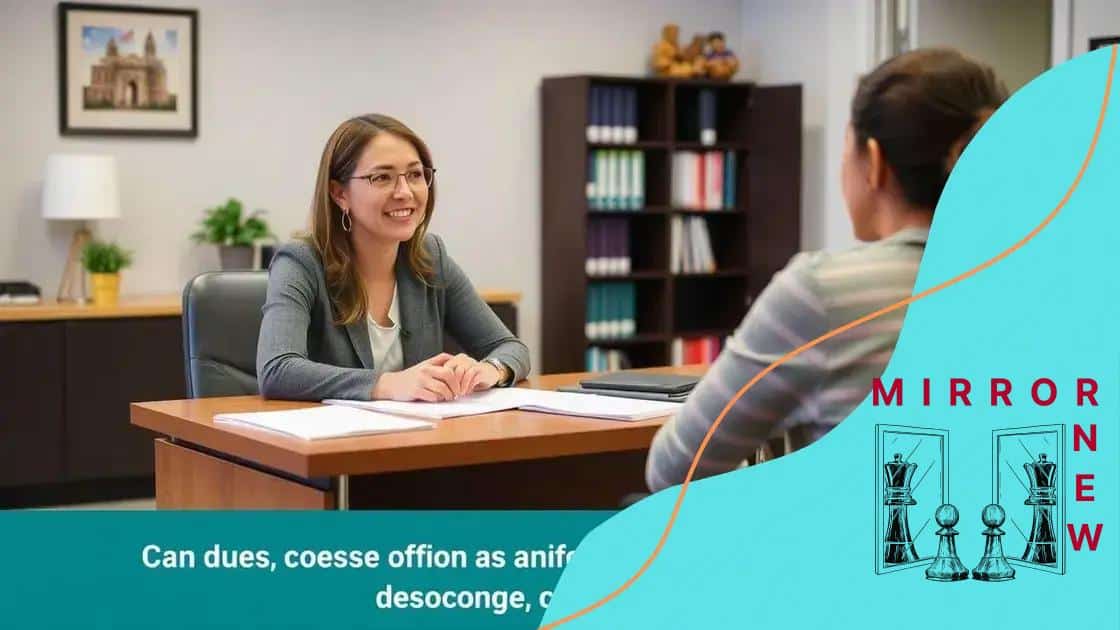How to help students choose a course and college

To help students choose a course and college, focus on understanding their interests, researching options, utilizing academic advisors, evaluating programs and financial aid, and creating a structured decision-making timeline.
How to help students choose a course and college is a question many parents and educators grapple with. Have you ever thought about the challenges students face when making such significant decisions? This guide aims to shed light on effective strategies for supporting them.
Understanding student interests and strengths
Understanding student interests and strengths is essential for choosing a suitable course and college. When students explore their options, they should focus on what they enjoy and excel at. This approach lays a strong foundation for their academic journey.
Identifying Interests
To begin, students can ask themselves questions about their hobbies and passions. Reflecting on what they love will help them uncover potential career paths. They might consider:
- What subjects do they enjoy the most?
- Are there activities they look forward to doing?
- Which skills do they feel confident in?
As students ponder these questions, they often find clues about fields that excite them. Engaging in extracurricular activities can also reveal new interests.
Recognizing Strengths
Once students have a grasp on their interests, the next step is to evaluate their strengths. Self-assessment tools or feedback from teachers can help highlight areas of talent.
- Academic performance in specific subjects
- Positive feedback from peers and mentors
- Skills acquired from hobbies or part-time jobs
By understanding their strengths, students can align their educational choices with their abilities. This alignment makes the learning process more enjoyable and fruitful. For instance, a student who excels in math may find a rewarding career in engineering.
Moreover, it’s essential for students to seek advice from family and teachers. These individuals can offer insights and encouragement, helping them see potential paths they may not have considered. Communication with mentors can also clarify how interests translate into careers.
At the same time, students should remain open to exploring new fields. Interests can evolve, and discovering new strengths can lead to fulfilling opportunities. This growth mindset encourages adaptability and continuous learning.
Ultimately, the journey of understanding interests and strengths is personal and dynamic. By actively engaging in self-exploration, students create a roadmap that can guide them through their educational choices.
Researching potential courses and colleges
Researching potential courses and colleges is a vital step in helping students make informed choices. This process may feel overwhelming, but with a structured approach, students can identify the best options to fit their aspirations.
Exploring Course Options
Students should begin by listing their areas of interest and the fields they enjoy. This list can guide their search for relevant courses. Inquiry into course content, career prospects, and related skills will help them make educated decisions.
- Look into course syllabi to understand the topics covered.
- Consider the type of learning format, whether online, in-person, or hybrid.
- Read reviews from current and former students.
Additionally, students can visit educational websites that specialize in courses and career guidance. These platforms often provide helpful information that simplifies their research process.
Evaluating Colleges
After narrowing down potential courses, it’s important to evaluate colleges where these programs are offered. Factors like location, campus culture, and support services can greatly influence a student’s experience.
- Check the college’s accreditation status to ensure quality education.
- Explore available extracurricular activities and support resources.
- Research the college’s reputation in the chosen field.
Students can benefit from virtual tours and open days to get a feel for the environment. Speaking with current students offers valuable insight into daily life at the college.
Networking also plays a critical role in this process. Reaching out to alumni can provide firsthand experiences about the courses taken and career paths pursued. Engaging with professionals in the field helps students understand how their education aligns with industry expectations.
It’s essential to gather information from multiple sources. Checking university rankings and discussing options with academic advisors can clarify which courses and colleges align best with student goals. This research phase is crucial for ensuring that students choose paths that resonate with their identities and career ambitions.
The role of academic advisors

The role of academic advisors is crucial in guiding students through their educational journey. Advisors provide support in decision-making, helping students align their interests and strengths with educational opportunities.
Guidance in Course Selection
Academic advisors assist students in choosing the right courses that fit their graduation requirements and career goals. This support can reduce the chances of changing majors or extending college time.
- They help students understand degree requirements.
- Advisors offer insights into which courses lead to specific careers.
- They can suggest electives that match students’ interests.
Having an experienced advisor can help in navigating complex course catalogs and prerequisites, making it a smoother process for students.
Providing Resources
Academic advisors also connect students with valuable resources like tutoring services, academic workshops, and career counseling. These resources help improve students’ skills and enhance their overall learning experience.
- They can refer students to financial aid advisors for funding options.
- Advisors may provide information about internships and job opportunities.
- They can also suggest study groups and peer mentoring programs.
Through these connections, students gain insights that enrich their education and prepare them for the job market. Regular meetings with advisors foster a relationship that can evolve over time, benefiting students as they advance through their studies.
Furthermore, academic advisors encourage students to take advantage of extracurricular activities. These experiences, like clubs and organizations, can be valuable for personal growth and networking.
Students should schedule regular meetings with their advisors to stay on track. This consistent communication ensures that students remain aware of their requirements and available opportunities, ultimately enhancing their academic success.
Evaluating college programs and financial aid
Evaluating college programs and financial aid is a key part of the college selection process. When students understand their options, they can make informed decisions that align with their goals.
Understanding College Programs
Each college offers a variety of programs that cater to different interests and career paths. Students should examine the curriculum to ensure it meets their educational needs. It’s important to ask questions about:
- The courses included in the program and their relevance.
- The qualifications of the instructors teaching the courses.
- Opportunities for hands-on experience through internships or labs.
Additionally, researching the college’s reputation in specific fields can provide insight into the quality of education students can expect.
Considering Financial Aid Options
Financial aid can significantly influence college choices. Students should explore the types of financial aid available, including scholarships, grants, and loans. This understanding helps in planning their finances for college.
- Research merit-based and need-based scholarships offered by the college.
- Understand federal and state financial aid programs.
- Consider work-study options to gain experience while earning money.
It’s also wise for students to complete the Free Application for Federal Student Aid (FAFSA) as early as possible to maximize their financial aid eligibility. Financial aid offices at colleges can provide personalized assistance and guidance tailored to each student’s situation.
Creating a budget that accounts for tuition, books, and living expenses is vital for managing funds throughout college. This financial literacy will enable students to focus on their studies rather than financial stress.
In addition to evaluating financial aid offers, students should consider the overall value of the education they will receive. Balancing program quality with affordability is crucial in making a long-term investment in their future.
Creating a decision-making timeline
Creating a decision-making timeline is essential for students navigating their course and college choices. A timeline helps organize tasks and deadlines, making the process less overwhelming.
Identifying Key Milestones
The first step in building a timeline is to identify major milestones. These milestones include:
- Researching potential courses and colleges.
- Preparing and taking standardized tests, if needed.
- Completing college applications and financial aid forms.
By clarifying these crucial points, students can visualize their journey and set realistic deadlines.
Setting Realistic Deadlines
Once the milestones are established, it’s important to set realistic deadlines for each task. Students should consider their other commitments, like schoolwork and extracurricular activities, as they plan.
- Plan to complete research and visits by a specific date.
- Schedule standardized test dates well in advance to allow for preparation.
- Set a deadline for finishing college applications a few weeks before they are due.
Breaking the timeline into manageable segments makes the process feel less daunting. It allows students to focus on one task at a time without feeling rushed.
Additionally, students should include time for reflection in their timeline. After completing significant tasks, taking a moment to evaluate their choices can help solidify their decisions.
Regularly reviewing the timeline ensures students stay on track. They can adjust deadlines as needed if new opportunities or challenges arise. Flexibility is key to managing any adjustments in plans.
Utilizing tools such as planners or digital calendars can make it easier to visualize the timeline. Color-coding different tasks can also help in distinguishing between academic deadlines and personal activities, creating a balance.
In conclusion, helping students navigate their choices for courses and colleges involves understanding their interests, researching options, seeking guidance from advisors, evaluating programs and financial aid, and creating a decision-making timeline. By following these steps and remaining organized, students can find paths that align with their aspirations and career goals, reducing stress along the way. With the right support and resources, they can embark on their academic journeys with confidence!
FAQ – Frequently Asked Questions about Helping Students Choose a Course and College
How can students identify their interests when choosing a course?
Students can explore their hobbies, interests, and subjects they enjoy in school to better understand what they might like to pursue.
What resources are available for researching colleges and courses?
Students can use college websites, educational platforms, and forums to gather information about courses, reviews, and college experiences.
How do academic advisors assist students in the decision-making process?
Academic advisors provide guidance on course selection, available resources, and career paths, helping students make informed decisions.
Why is creating a decision-making timeline important?
A decision-making timeline helps students manage their tasks and deadlines effectively, reducing stress and ensuring they stay organized.





